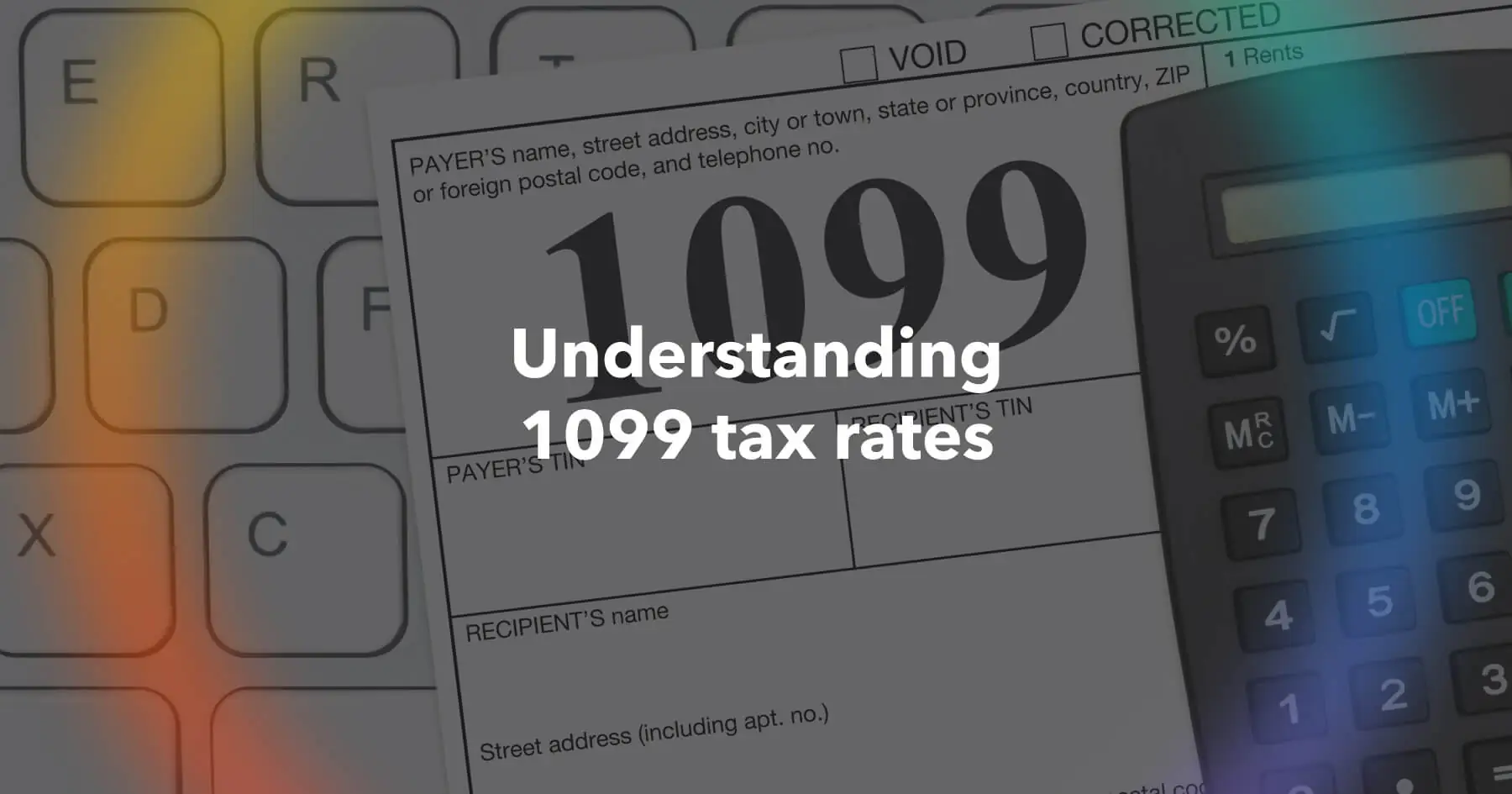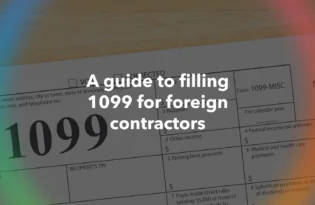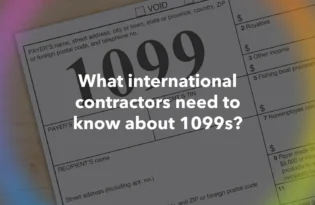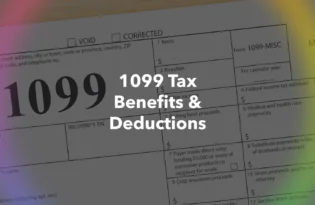Understanding 1099 tax rates
Learn about the tax rate on 1099 income, key factors that impact it, how to calculate it and more.

Temporary employees or independent contractors need to be aware of their tax responsibilities. The tax rate on 1099 income is approximately 15.3% plus your federal income tax, which varies according to your filing status and total income.
IRS Form 1040-ES may be used to compute and pay quarterly taxes to mitigate penalties.
What is the tax rate on 1099 income?
Unlike traditional W-2 workers, whose employers pay part of their taxes, 1099 workers have to cover the part of their Social Security and Medicare taxes that employees and employers split between them. This is known as the self-employment tax, set at a rate of 15.3%.
The breakdown is as follows:
- 12.4% for Social Security (up to the annual income cap, which is $168,600 for 2024)
- 2.9% for Medicare (with no income cap)
High earners also face an additional 0.9% Medicare tax on wages above $200,000 (for single filers) and $250,000 (for joint filers) as part of the Affordable Care Act.
To handle their tax liabilities, many companies that use 1099s seek a way to use the IRS’s 1099 estimated tax calculator. This tool helps estimate quarterly payments and prevents underpayment penalties.
Learning how to calculate 1099 taxes also involves understanding which deductions you’re eligible for, such as home office expenses, mileage, software subscriptions, and business insurance.
How much do contractors typically owe in taxes?
In the case of independent contractors, the amount to be paid depends on various facts to be considered each tax year.
- Gross income is all the money you make from your freelance or contract work, before any deductions. “Non-employee compensation,” the amount being reported on Form 1099-NEC, is also the “other income” you have received that is not subject to withholding.
- Business expenses can significantly reduce your taxable income. These include costs such as internet services, office supplies, equipment, mileage, and home office expenses, provided they are ordinary and necessary for the performance of your work.
- Tax deductions and credits to help you save or claim what you owe. You have the option of taking the standard deduction, or itemizing deductions (credits such as the Saver’s Credit for contributions to a retirement plan or the Lifetime Learning Credit for continuing education.
To comply with IRS requirements, contractors are generally expected to make quarterly estimated tax payments.
This is where how to do 1099 taxes becomes particularly important. The IRS requires these payments if you expect to owe at least $1,000 in taxes when your return is filed. Using IRS Form 1040-ES may help you estimate these amounts accurately.
How to calculate estimated taxes for 1099 income
Here’s how to figure out your quarterly tax payments if you’re earning as a freelancer or independent contractor:
- Start by looking at how much money you expect to make this year, from freelance jobs, side gigs, 1099s, interest, and other sources. Write down the total.
- Next, consider deductible business expenses, such as home office costs, internet, mileage, and software subscriptions.
- Subtract your allowable deductions from your total income to determine what you’ll be taxed on.
- Refer to the current IRS tax tables to estimate your federal income tax liability. If you’re asking, what is the tax rate on 1099 income, it includes both income tax and self-employment tax components.
- Use the current 1099 tax rate, which includes a 15.3% rate for Social Security and Medicare on net earnings from self-employment.
- Add your income tax and self-employment tax liabilities.
To simplify this process, you may use the 1099 estimated tax calculator provided by the IRS.
Key factors that affect 1099 income tax
Several factors can significantly impact your overall 1099 income tax liability.
- Filing status: Whether you file as single, married jointly, or head of household directly influences your tax bracket and federal income tax rates.
- Income level: Higher earnings may trigger additional taxes, such as the 0.9% Medicare surtax, which applies beyond certain income thresholds.
- Business structure: Your entity type, whether you’re a sole proprietor, LLC, or S corporation, can alter how the 1099 tax rate applies and affect your eligibility for deductions and self-employment tax.
- State and local taxes: These vary widely and are imposed in addition to federal obligations, further affecting your total tax burden.
Using the 1099 estimated tax calculator
1099 estimated tax calculator, provided by the IRS, helps individuals project their tax liability based on current income, deductions, and tax credits, ultimately reducing the risk of underpayment penalties.
Unlike employees who have taxes withheld automatically, 1099 workers must actively estimate and pay taxes throughout the year. The calculator takes into account self-employment tax, federal income tax brackets, and applicable deductions. It’s especially useful for those wondering how to do 1099 taxes correctly and avoid surprises during tax season.
Legal acts related to 1099 tax rates
Understanding the legal framework governing 1099 tax rates is essential for compliance:
- Self-Employment Contributions Act (SECA): Governs the self-employment tax rate of 15.3%.
- Internal Revenue Code (IRC) Section 1401: Details the imposition of self-employment tax.
- IRC Section 6011: Requires individuals to file returns and pay taxes.
Manage contractors with Payoneer Workforce Management
Managing taxes, compliance, and payments across borders doesn’t have to be a legal maze. Payoneer Workforce Management helps simplify contractor management while scaling your global contractor workforce.
With Payoneer Workforce Management, you can:
- Hire contractors in 160+ countries without the paperwork headache
- Pay in 70+ currencies with near real-time speed
- Stay compliant with local tax and labor laws
- Mitigate misclassification risks and reduce penalties
- Onboard talent quickly, without tripping over legal red tape
- Enjoy transparent pricing, with no hidden surprises
Ready to simplify contractor management? Book your demo today.
FAQs on understanding 1099 tax rates
1) Is Form 1099 only for US citizens?
Yes, typically, foreign vendors aren’t required to file Form 1099. If a foreign national qualifies to submit IRS Form W-8BEN and doesn’t perform services within the United States, they won’t receive a 1099-NEC.
2) What is the 1099 form in the USA?
A set of tax forms known as IRS Form 1099 is used to record payments made by individuals or businesses that are typically not your employers.
3) Do I have to pay taxes if I only made a small amount on a 1099?
Yes, if you earn $400 or more in self-employment income, you’re required to file a tax return and may owe self-employment tax.
Disclaimer
- Skuad Pte Limited (a Payoneer group company) and its affiliates & subsidiaries provide EoR, AoR, and contractor management services.
- The information in this article/on this page is intended for marketing and informational purposes only and does not constitute legal, financial, tax, or professional advice in any context. Payoneer and Payoneer Workforce Management are not liable for the accuracy, or reliability of the information provided herein. Any opinions expressed are those of the individual author and may not reflect the views of Payoneer or Payoneer Workforce Management. All representations and warranties regarding the information presented are disclaimed. The information in this article/on this page reflects the details available at the time of publication. For the most up-to-date information, please consult a Payoneer Workforce Management representative or account executive.
- Availability of cards and other products is subject to customer’s eligibility. Not all products are available in all jurisdictions in the same manner. Nothing herein should be understood as solicitation outside the jurisdiction where Payoneer Inc. or its affiliates is licensed to engage in payment services, unless permitted by applicable laws. Depending on or your eligibility, you may be offered the Corporate Purchasing Mastercard, issued by First Century Bank, N.A., under a license by Mastercard® and provided to you by Payoneer Inc., or the Payoneer Business Premium Debit Mastercard®, issued and provided from Ireland by Payoneer Europe Limited under a license by Mastercard®.
Related resources
Latest articles
-
How to hire employees in Australia
Looking to hire employees in Australia for your US company? Learn about employment in Australia and how Payoneer Workforce Management makes it easy to hire in Australia.
-
Planning to hire employees in Germany? Here’s a quick guide
Looking to hire employees in Japan for your U.S. company? Learn about hiring practices in Japan and how Payoneer Workforce Management makes it easy to hire in Japan.
-
Planning to hire employees in the Philippines? Here’s a quick guide
Wondering how an American company hires employees in the Philippines? Our guide covers how to hire employees in the Philippines and how we can help.
-
Planning to hire employees in Japan? Here’s a quick guide
Looking to hire employees in Japan for your U.S. company? Learn about hiring practices in Japan and how Payoneer Workforce Management makes it easy to hire in Japan.
-
Planning to hire in Hong Kong? Here’s a quick guide
Are you hiring employees in Hong Kong for your U.S. company? Learn about employment in Hong Kong and how Payoneer Workforce Management makes it easy to hire in Hong Kong.
-
Planning to hire in Colombia? Here’s a quick guide
Looking to hire employees in Colombia for your U.S. company? Learn about employment in Colombia and how Payoneer Workforce Management makes it easy to hire in Colombia.















